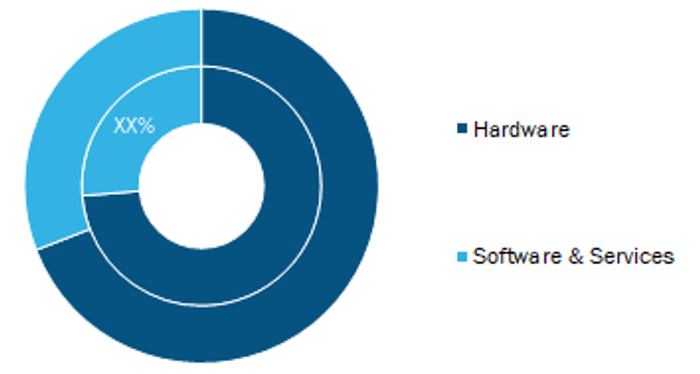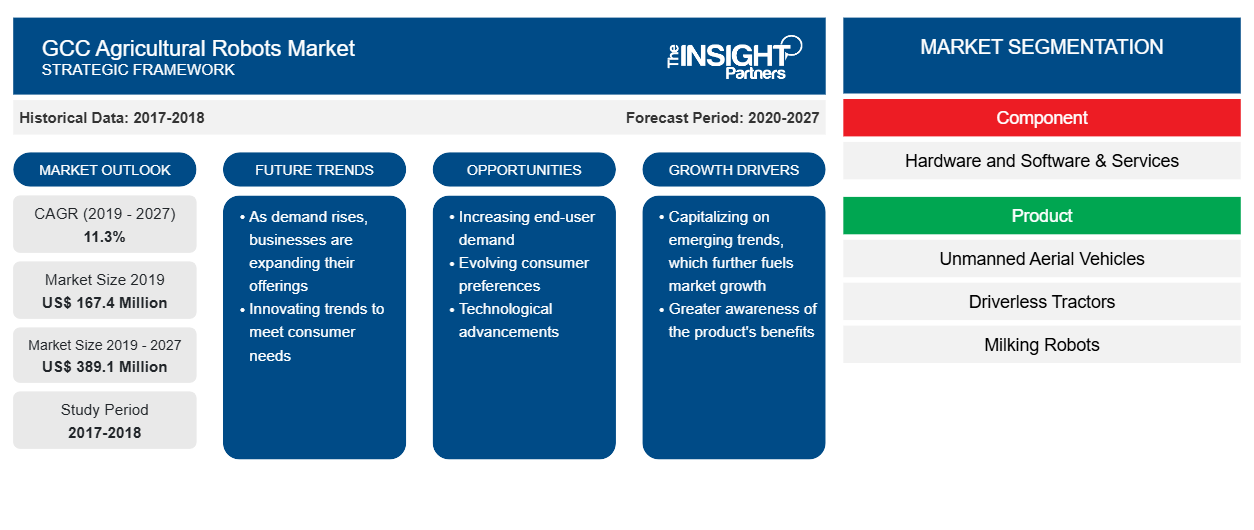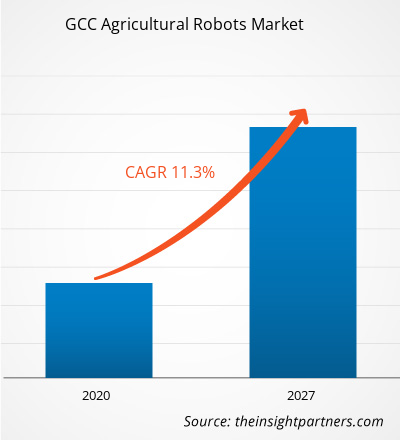The GCC agricultural robots market was valued at US$ 167.4 Mn in 2019 and is estimated to reach US$ 389.1 Mn by 2027; it is expected to grow at a CAGR of 11.3% from 2019 to 2027.
However, the market is projected to experience a dip in the growth rate during 2020 due to the impact of COVID-19 pandemic on the industry.The growth of the IoT industry has revolutionized the agriculture industry, which depends mainly on technology, electronics, and physical and biological sciences. In addition, increasing labor prices and untrained labor have also encouraged farmers to use a cost-effective approach to improve productivity. Moreover, robotic systems with vision systems and sensors may be specially built to assess the location and ripeness of the crops that need to be harvested. This can be designed to withstand extreme environments in the world, including changing light strength, rain, wind rafts, and temperature swings. Agricultural robots are configured to ensure a minimal human interference, to speed up the farming processes. Farmers are getting used to the effective use of robots, robotic weapons, or autonomous tractors. Farmers can automate routine, sluggish, and dull tasks using such agricultural robots; this helps them to focus more on improving the overall production yield.
Impact of COVID-19 Pandemic on GCC Agricultural Robots Market
The GCC countries, including Saudi Arabia, Kuwait, Oman, Qatar, the United Arab Emirates (UAE), and Bahrain, introduced a range of precautionary steps to deter COVID-19 infection and contain the spread of the same, effective from during March 2020. Technological advancements are expected to boost the demand for agricultural robots in the GCC countries. Artificial intelligence (AI), virtual reality (VR), and augmented reality (AR) are expected to contribute significantly in adapting to the COVID-19 pandemic and solving ever-evolving challenges. Using AI can help to reduce operating costs while enhancing customer satisfaction during the renewal process and other services. VR/AR can also prove valuable in providing remote support.
Market Insights- GCC Agricultural Robots Market
Growing Population and Increasing Labor Shortage are Encouraging Automation
In over 30 years, the world population is projected to grow from 7.7 billion to 9.7 billion owing to which food consumption is predicted to increase significantly. Traditional methods, however, are not sufficient to address this upsurge. Moreover, the younger generation does not foresee farming as an attractive profession, and immigration policies across the world make it challenging to get migrant workers. Therefore, a new breed of robotic staff is being deployed in the farms, including systems ranging from UAVs to driverless cars. Agricultural robots minimize he costs incurred by farmers' wages. Moreover, humans have limited working hours, while robots can work all day, year round. Thus, agricultural robots are becoming commonplace for farmers owing to barriers caused with increasing labor shortage and growing demand for food with rising population. Further, agricultural robots contribute in many ways—economically (e.g., growing and harvesting efficiently and cost-effectively), ecologically (e.g., reducing and eliminating chemical use while ensuring soil health), and ethically (e.g., increasing animal welfare through monitoring and early intervention). Thus, the growing population and increasing labor shortage that encourage the adoption of automation are among the major factors driving the growth of GCC agricultural robots market.
Component-Based Insights–GCC Agricultural Robots Market
The GCC agricultural robots market based on components segmented into hardware, and software and services. The hardware segment led the GCC agricultural robots market in 2019.
GCC Agricultural Robots Market, by Component– 2019 and 2027

- This FREE sample will include data analysis, ranging from market trends to estimates and forecasts.
Product-BasedInsights- GCC Agricultural Robots Market
On the basis of product, the GCC agriculture robots market is segmented into unmanned aerial vehicles, driverless tractors, milking robots, automated harvesting systems, and others. The milking robots segment led the GCC agricultural robots market in 2019.
Application-Based Insights- GCC Agricultural Robots Market
On the basis of application, the GCC agricultural robots market is segmented into field farming, precision agriculture, dairy management, soil management, crop management, and others. The dairy management segment led the GCC agricultural robots market in 2019.
Customize This Report To Suit Your Requirement
You will get customization on any report - free of charge - including parts of this report, or country-level analysis, Excel Data pack, as well as avail great offers and discounts for start-ups & universities
GCC Agricultural Robots Market: Strategic Insights

- Get Top Key Market Trends of this report.This FREE sample will include data analysis, ranging from market trends to estimates and forecasts.
You will get customization on any report - free of charge - including parts of this report, or country-level analysis, Excel Data pack, as well as avail great offers and discounts for start-ups & universities
GCC Agricultural Robots Market: Strategic Insights

- Get Top Key Market Trends of this report.This FREE sample will include data analysis, ranging from market trends to estimates and forecasts.
The market players focus on new product innovations and developments to achieve sustainable growth and distinguish themselves among competitors present in the highly competitive GCC agricultural robots market.
- In 2018, Yanmar launched new autonomous tractors that utilize precision positioning data and robot technology. The new autonomous driving “Robot Tractors” are designed to greatly enhance farm management efficiency, while realizing significant labor-savings. Agricultural machinery equipped with the “SMARTPILOT” autonomous operating system would fortify Yanmar’s already impressive lineup of industrial farm machinery.
The report segments the GCC agricultural robots market as follows:
By Component
- Hardware
- Software and Services
By Product
- Unmanned Aerial Vehicles
- Driverless Tractors
- Milking Robots
- Automated Harvesting Systems
- Other
By Application
- Field Farming
- Precision Agriculture
- Dairy management
- Soil Management
- Crop Management
- Other
By Country
- Saudi Arabia
- UAE
- Qatar
- Rest of GCC
GCC Agricultural Robots Market Regional Insights
The regional trends and factors influencing the GCC Agricultural Robots Market throughout the forecast period have been thoroughly explained by the analysts at The Insight Partners. This section also discusses GCC Agricultural Robots Market segments and geography across North America, Europe, Asia Pacific, Middle East and Africa, and South and Central America.
GCC Agricultural Robots Market Report Scope
| Report Attribute | Details |
|---|---|
| Market size in 2019 | US$ 167.4 Million |
| Market Size by 2027 | US$ 389.1 Million |
| Global CAGR (2019 - 2027) | 11.3% |
| Historical Data | 2017-2018 |
| Forecast period | 2020-2027 |
| Segments Covered |
By Component
|
| Regions and Countries Covered | GCC
|
| Market leaders and key company profiles |
GCC Agricultural Robots Market Players Density: Understanding Its Impact on Business Dynamics
The GCC Agricultural Robots Market is growing rapidly, driven by increasing end-user demand due to factors such as evolving consumer preferences, technological advancements, and greater awareness of the product's benefits. As demand rises, businesses are expanding their offerings, innovating to meet consumer needs, and capitalizing on emerging trends, which further fuels market growth.

- Get the GCC Agricultural Robots Market top key players overview
- Historical Analysis (2 Years), Base Year, Forecast (7 Years) with CAGR
- PEST and SWOT Analysis
- Market Size Value / Volume - Global, Regional, Country
- Industry and Competitive Landscape
- Excel Dataset
Recent Reports
Testimonials
Reason to Buy
- Informed Decision-Making
- Understanding Market Dynamics
- Competitive Analysis
- Identifying Emerging Markets
- Customer Insights
- Market Forecasts
- Risk Mitigation
- Boosting Operational Efficiency
- Strategic Planning
- Investment Justification
- Tracking Industry Innovations
- Aligning with Regulatory Trends
Yes! We provide a free sample of the report, which includes Report Scope (Table of Contents), report structure, and selected insights to help you assess the value of the full report. Please click on the "Download Sample" button or contact us to receive your copy.
Absolutely - analyst assistance is part of the package. You can connect with our analyst post-purchase to clarify report insights, methodology or discuss how the findings apply to your business needs.
Once your order is successfully placed, you will receive a confirmation email along with your invoice.
• For published reports: You'll receive access to the report within 4-6 working hours via a secured email sent to your email.
• For upcoming reports: Your order will be recorded as a pre-booking. Our team will share the estimated release date and keep you informed of any updates. As soon as the report is published, it will be delivered to your registered email.
We offer customization options to align the report with your specific objectives. Whether you need deeper insights into a particular region, industry segment, competitor analysis, or data cut, our research team can tailor the report accordingly. Please share your requirements with us, and we'll be happy to provide a customized proposal or scope.
The report is available in either PDF format or as an Excel dataset, depending on the license you choose.
The PDF version provides the full analysis and visuals in a ready-to-read format. The Excel dataset includes all underlying data tables for easy manipulation and further analysis.
Please review the license options at checkout or contact us to confirm which formats are included with your purchase.
Our payment process is fully secure and PCI-DSS compliant.
We use trusted and encrypted payment gateways to ensure that all transactions are protected with industry-standard SSL encryption. Your payment details are never stored on our servers and are handled securely by certified third-party processors.
You can make your purchase with confidence, knowing your personal and financial information is safe with us.
Yes, we do offer special pricing for bulk purchases.
If you're interested in purchasing multiple reports, we're happy to provide a customized bundle offer or volume-based discount tailored to your needs. Please contact our sales team with the list of reports you're considering, and we’ll share a personalized quote.
Yes, absolutely.
Our team is available to help you make an informed decision. Whether you have questions about the report’s scope, methodology, customization options, or which license suits you best, we're here to assist. Please reach out to us at sales@theinsightpartners.com, and one of our representatives will get in touch promptly.
Yes, a billing invoice will be automatically generated and sent to your registered email upon successful completion of your purchase.
If you need the invoice in a specific format or require additional details (such as company name, GST, or VAT information), feel free to contact us, and we’ll be happy to assist.
Yes, certainly.
If you encounter any difficulties accessing or receiving your report, our support team is ready to assist you. Simply reach out to us via email or live chat with your order information, and we'll ensure the issue is resolved quickly so you can access your report without interruption.















The List of Companies - GCC Agricultural Robots
- SZ DJI Technology Co, Ltd.
- GEA Group
- Topcon Corporation
- Trimble Inc.
- Yanmar Holdings Co., Ltd.






 Get Free Sample For
Get Free Sample For